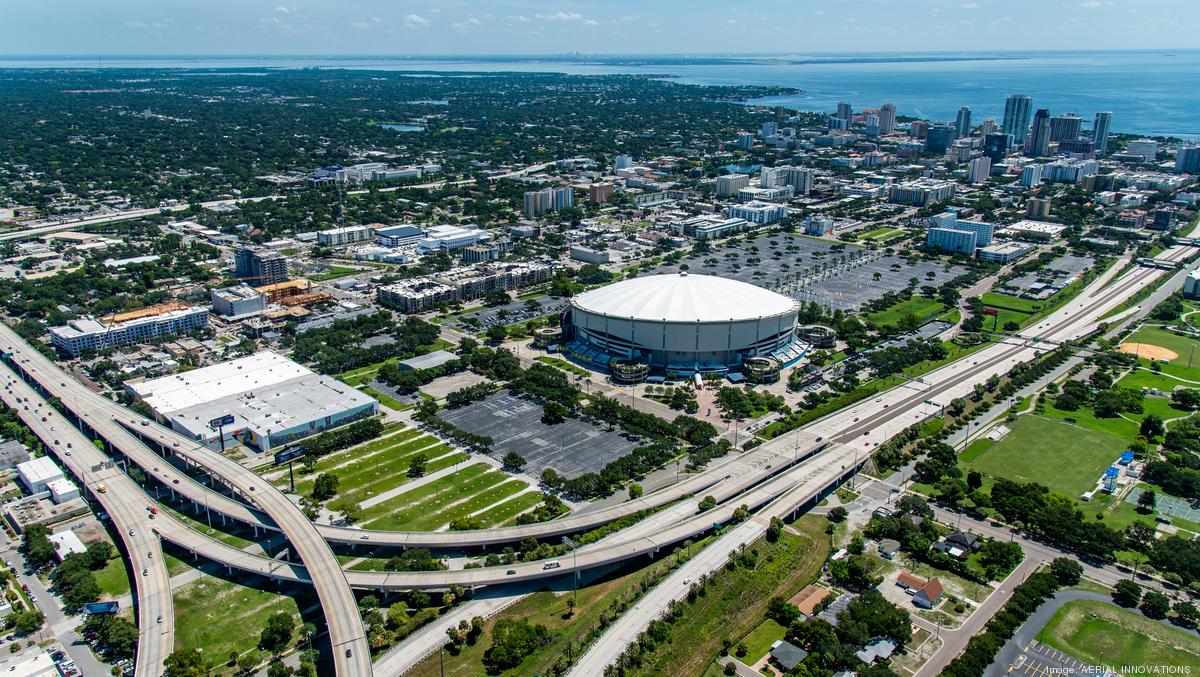
Two candidates; two plans.
With the St. Petersburg mayoral race narrowed to two, one of the biggest questions for the eventual winner will be what to do with the Tropicana Field redevelopment project.
Right now, the city is deciding between a pair of potential plans.
One proposal, put forward by Midtown Development, would feature 6,000 residential units, 3.3 million square feet of office space, 300,000 square feet of retail space, a hotel, conference center, and innovation complex.
The second, from Sugar Hill Community Partners, would bring a 1-million-square-foot conference center and a 640,342-square-foot hotel among a host of other amenities — or it would have until the company reversed course and submitted a substantially different offer at the last minute.
The contract selection process for the Trop redevelopment has been a long one. Nine developers originally submitted plans for the project. Through a monthslong process, the City of St. Petersburg winnowed them down to two.
It was clear then that Midtown’s offer was superior. In addition to its offer checking more boxes than Sugar Hill’s. If the city selects them, St. Petersburg residents can expect the company to deliver.
As for Sugar Hill, it’d be unrealistic to believe that the final product would line up with the plan they offered. This isn’t an unfair dig.
Some of the developers in Sugar Hill’s consortium submitted the winning bid on major development projects in the past. More often than not, its promises turn out to be empty.
JMA Ventures, the lead developer behind Sugar Hill, bungled a project in Sacramento, California, that bears some striking similarities to its St. Pete proposal. They pitched the city a plan to redevelop the area around the Sacramento Kings’ basketball arena.
The project was a mess, leading several downtown Sacramento businesses to go belly up. Worse yet, they were sued for not paying contractors for $26 million worth of work on the hotel.
St. Petersburg hasn’t been spared from the ineptitude in Sugar Hill’s ranks. J2 Developers were awarded the contract to build the new police station. The plan was supposed to bring 100,000 square feet of office space. After winning, the company changed the deal, cutting the square footage in half.
If they were only a few thousand square feet short, it would be disappointing but understandable. But promising 100,000 square feet and later changing it to 55,000 is a full-on bait-and-switch. Their plan for the Trop has all the trappings of another. But they at least had the courtesy to change the deal while there’s still time to reject it.
After St. Petersburg called “best and final” offers, the developer submitted an entirely different plan that includes a 100,000-square-foot convention center while keeping the same 640,342-square-foot hotel. That alone should make the city question whether Sugar Hill understands the market, but bigger concerns exist.
Sugar Hill also scratched out a major drawback to its plan: The company went from asking for $500 million in public funding to offering to pay $100 million. There’s no reason to believe that will happen, and many reasons to believe it won’t.
A cursory read of the fine print shows Sugar Hill would likely ask for millions more in taxpayer money down the line.
The developers dropped from contention are probably slamming their fists on the table, and rightly so. If Sugar Hill had submitted this plan to begin with, they might not have become a finalist.
Sugar Hill’s new plan is unvetted, and the selection timeline likely means it will remain that way. That it was changed so significantly should cause the alarm bells to go off. It now includes pie-in-the-sky promises that should raise more red flags than are placed on the beach the day before a hurricane hits.
Midtown’s best and final offer, by comparison, was largely the same. The only changes were adding some pot sweeteners, including a $10,000,000 local retail storefront program and funding for an I-175 highway task force. its plan still only calls for the already-budgeted $75 million in public money, including a commitment to pump $190 million into the city.
Midtown’s plan is solid. It’s realistic. It’s attractive. Most importantly, the developer behind it can deliver.
It’s unclear whether Sugar Hill’s 11th-hour 180 stems from incompetence or cynicism, but it doesn’t matter. What does matter is that their plan was inferior from the start? It remains so now. And the developers behind it simply cannot be trusted to follow through.
The Trop redevelopment project is transformational, and the decision on which company should handle it will have consequences.
With Midtown Development, what we see is what we’ll get.
With Sugar Hill, well, who knows?



